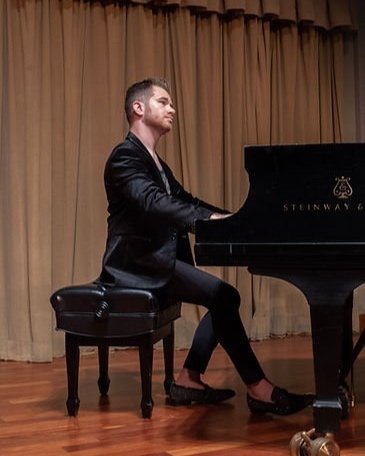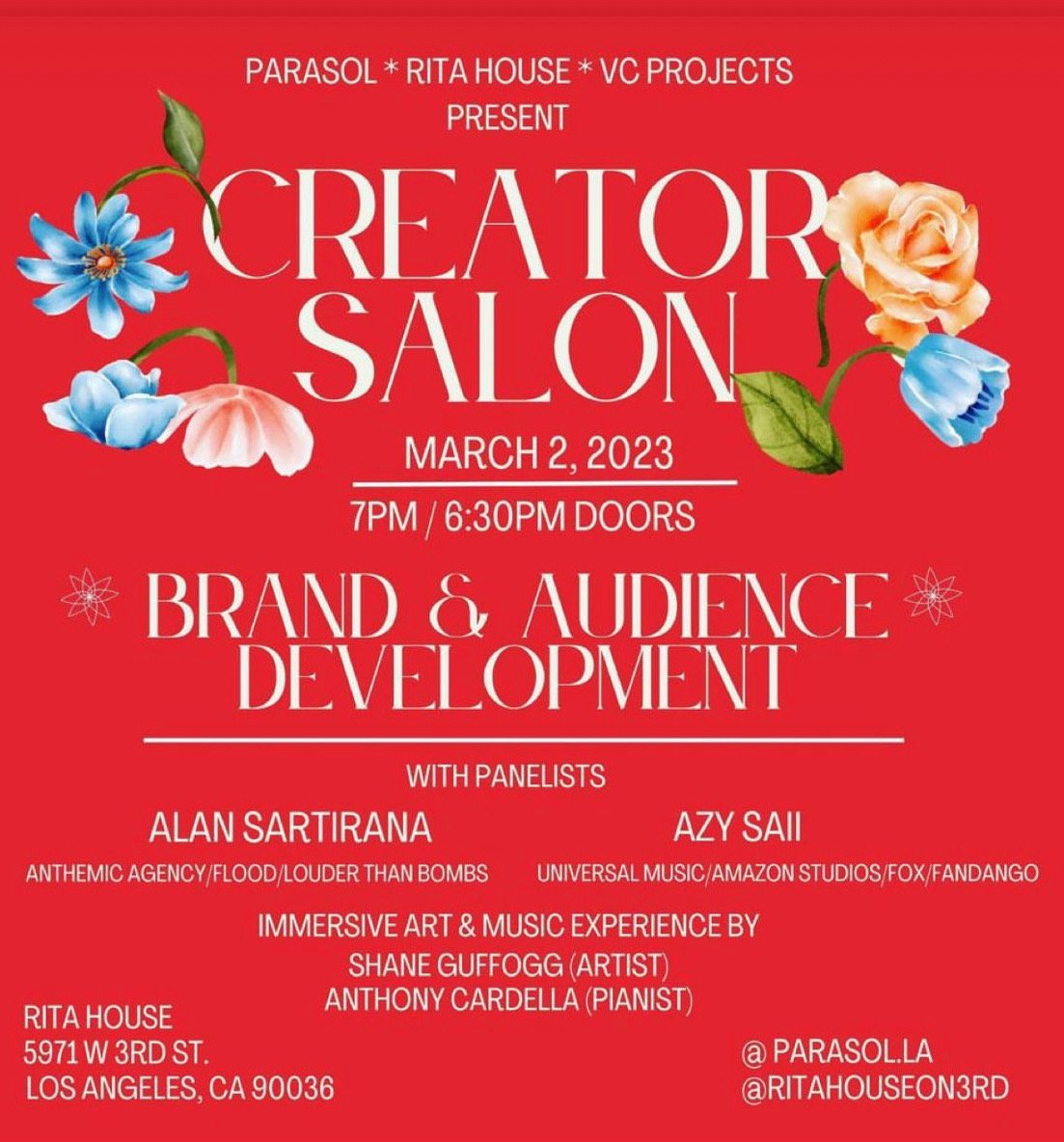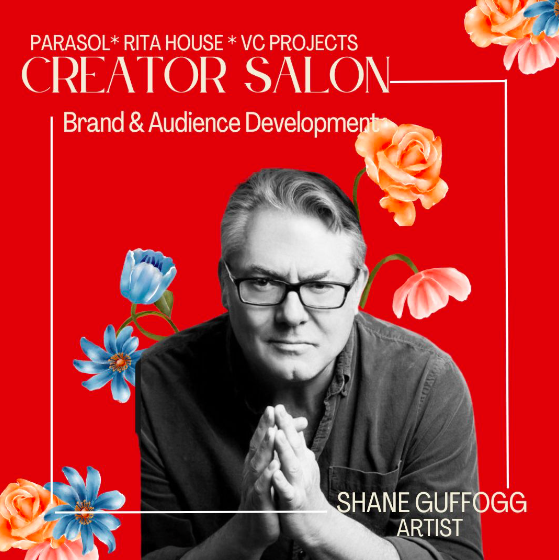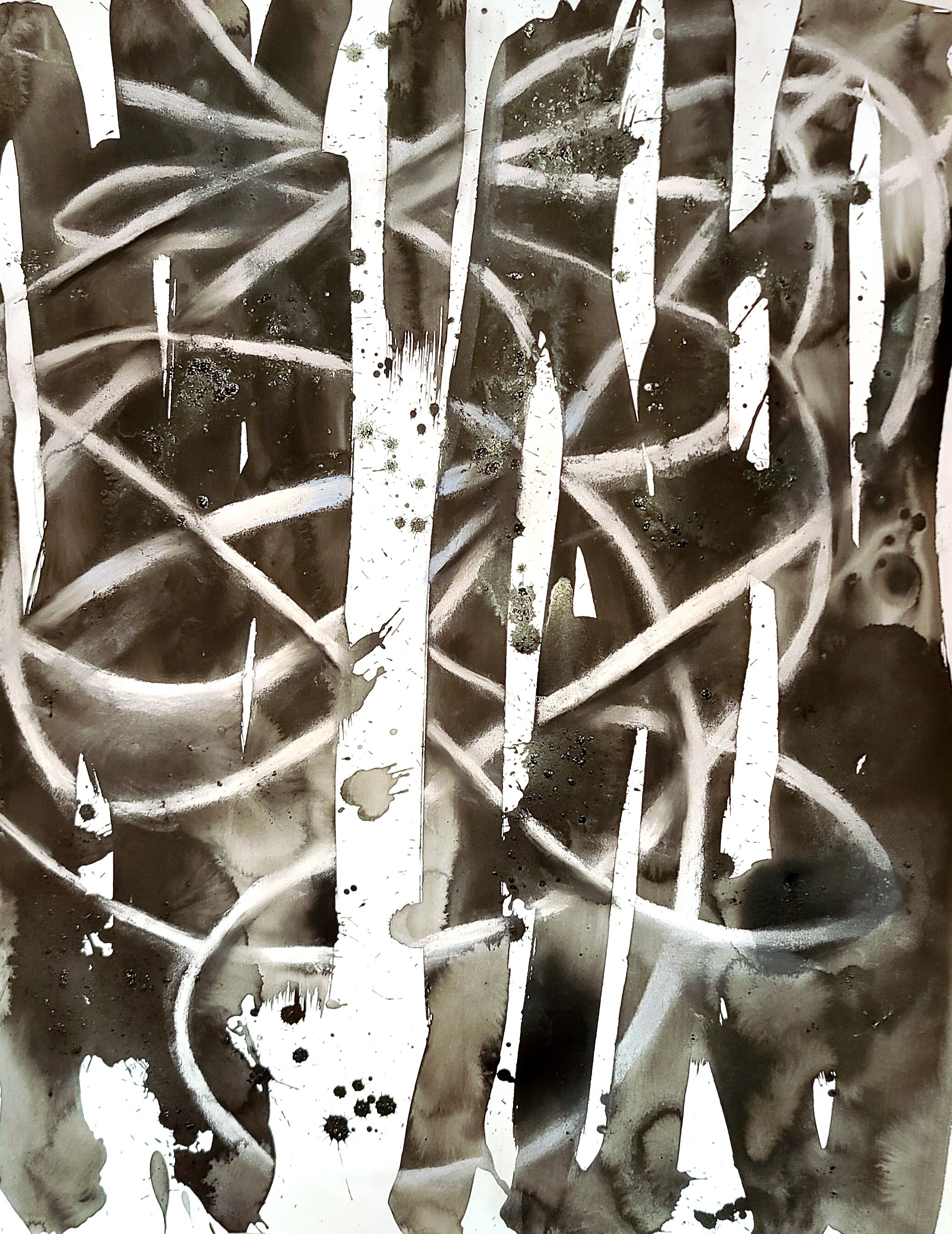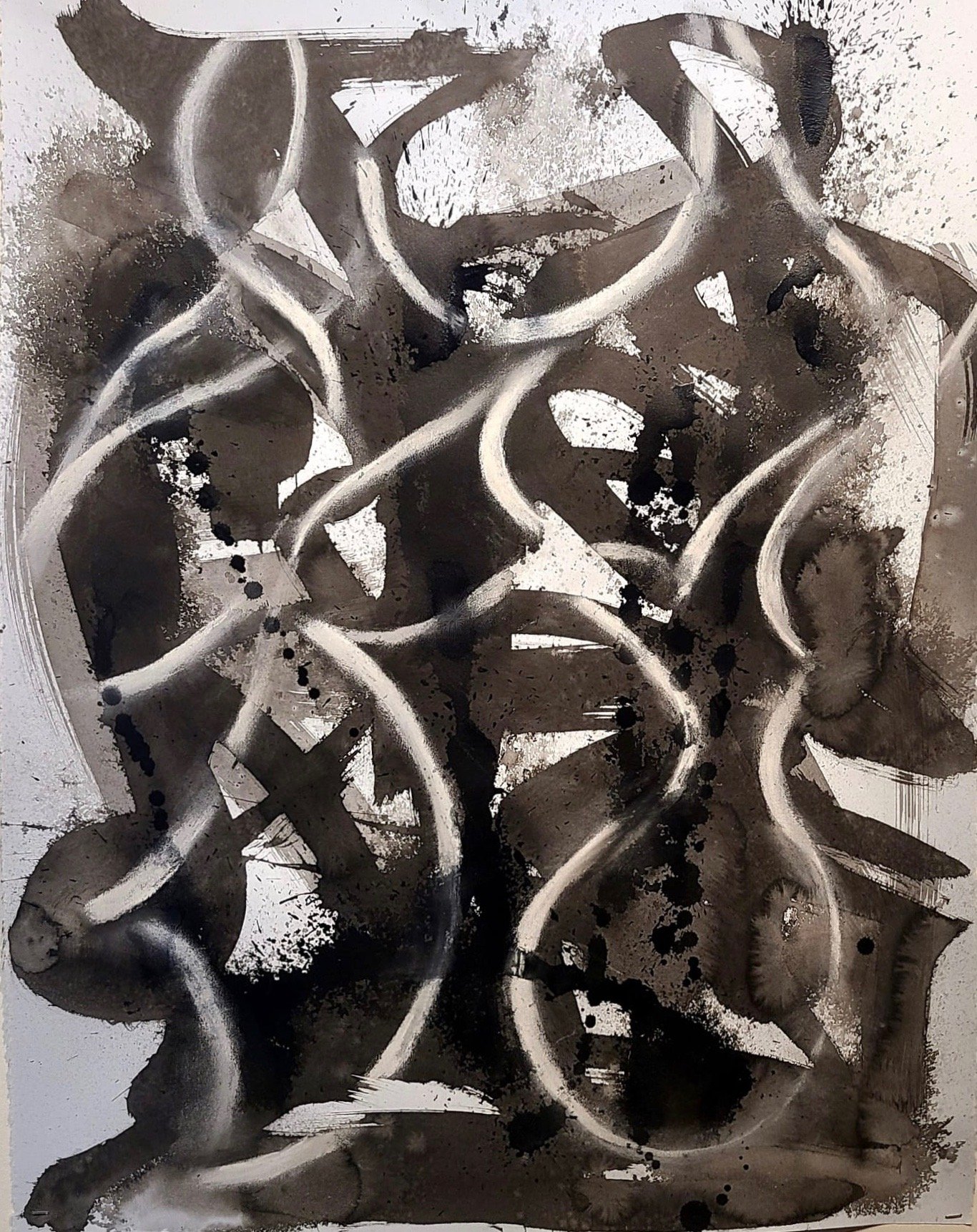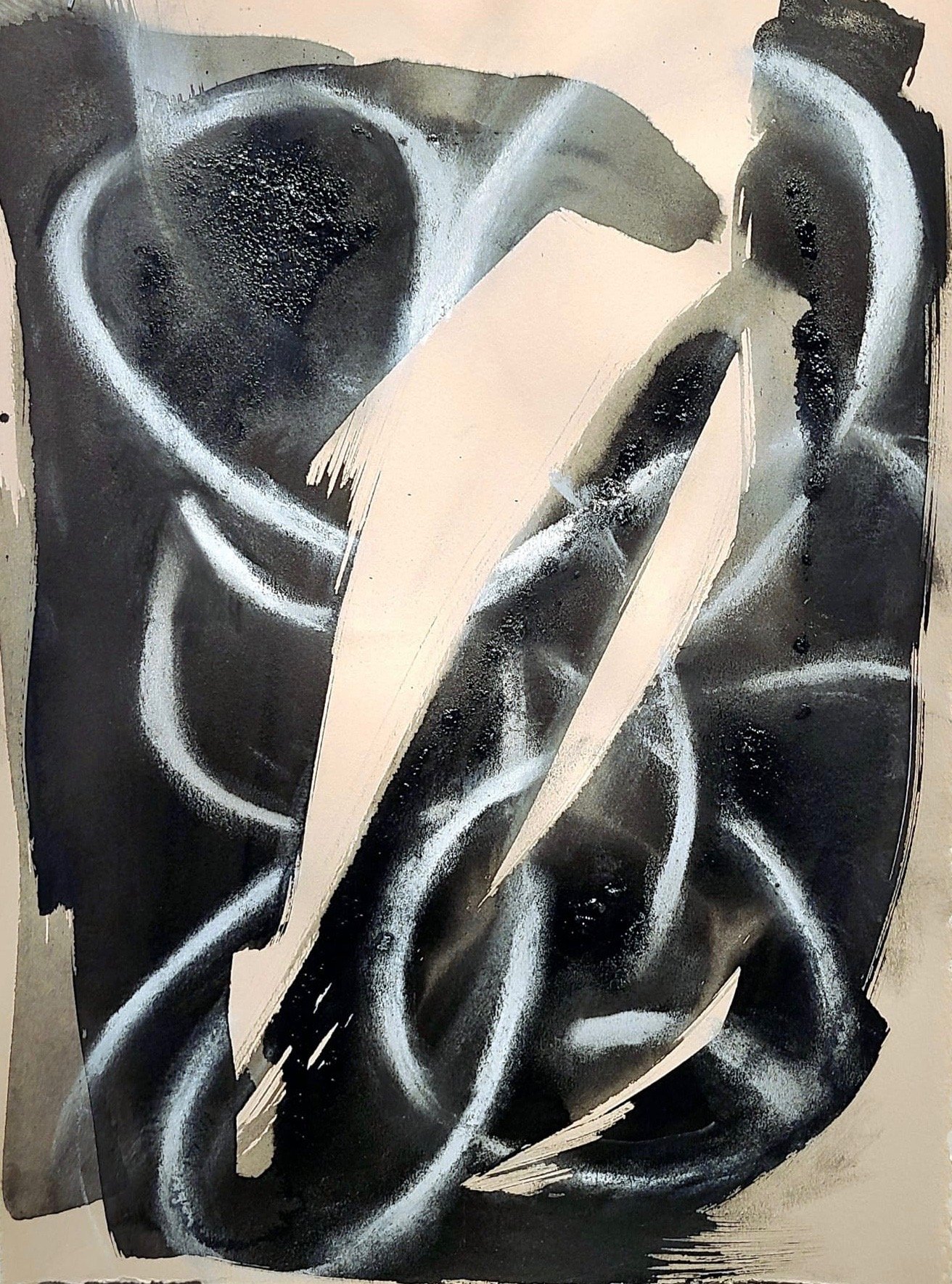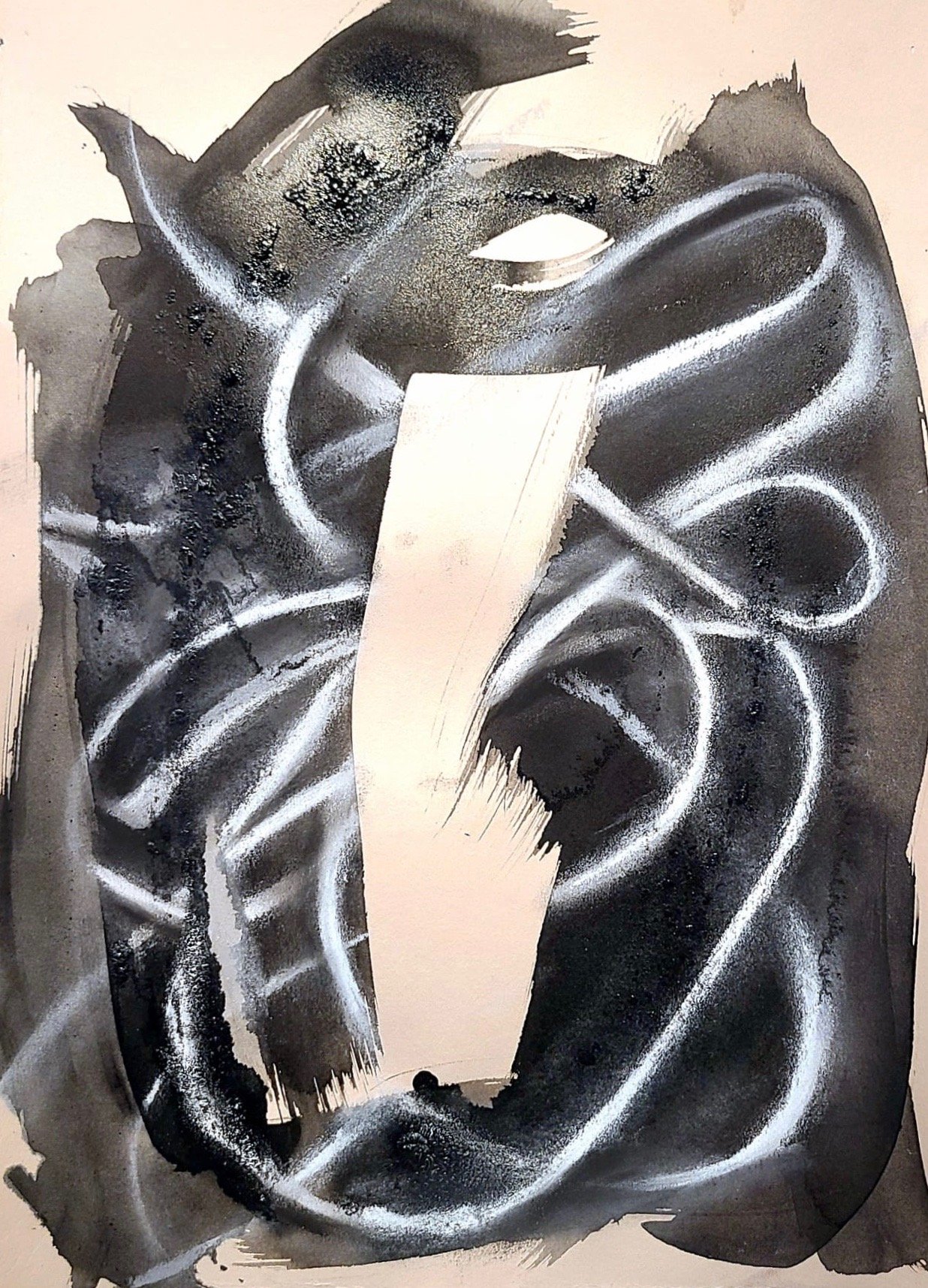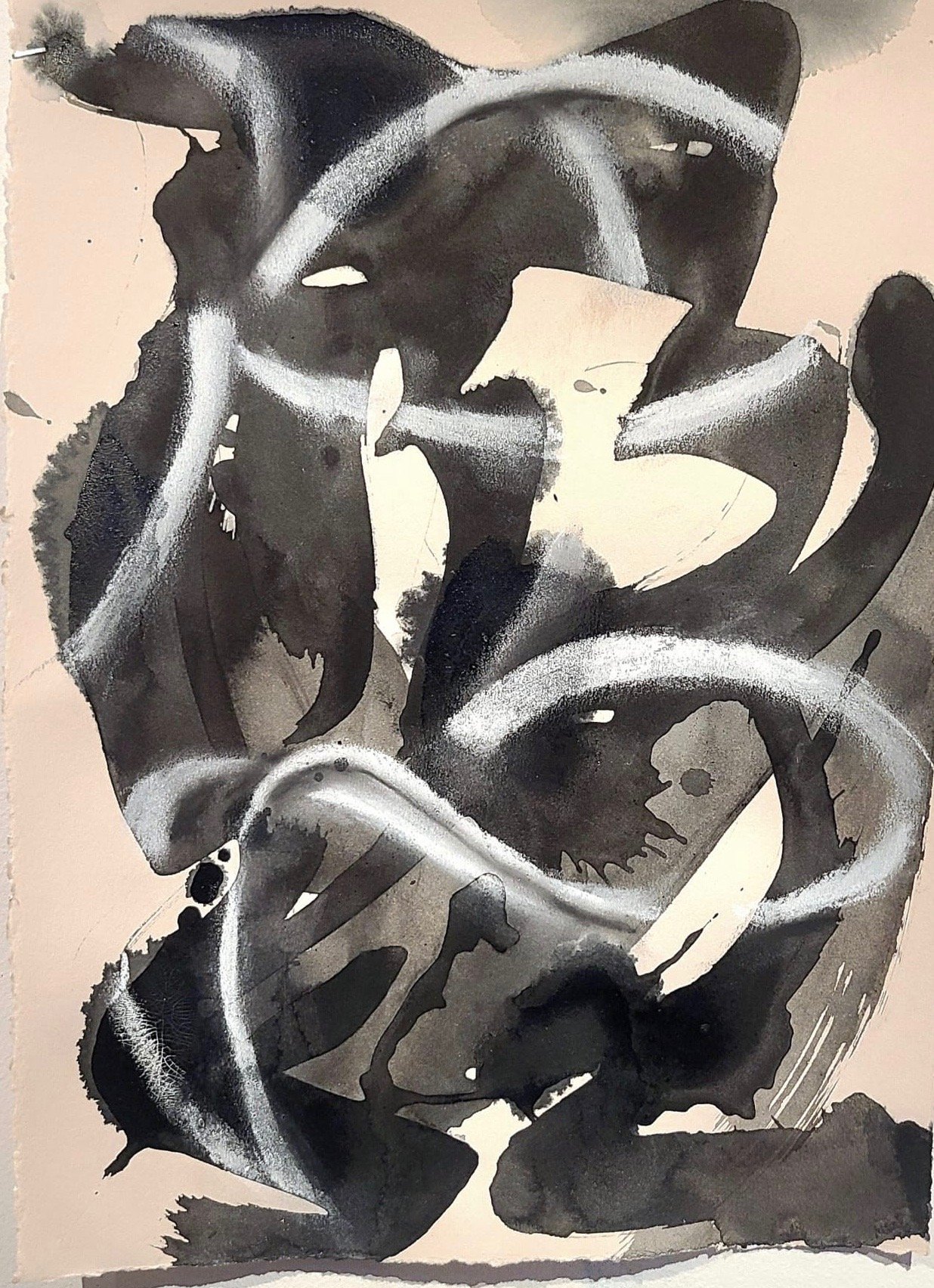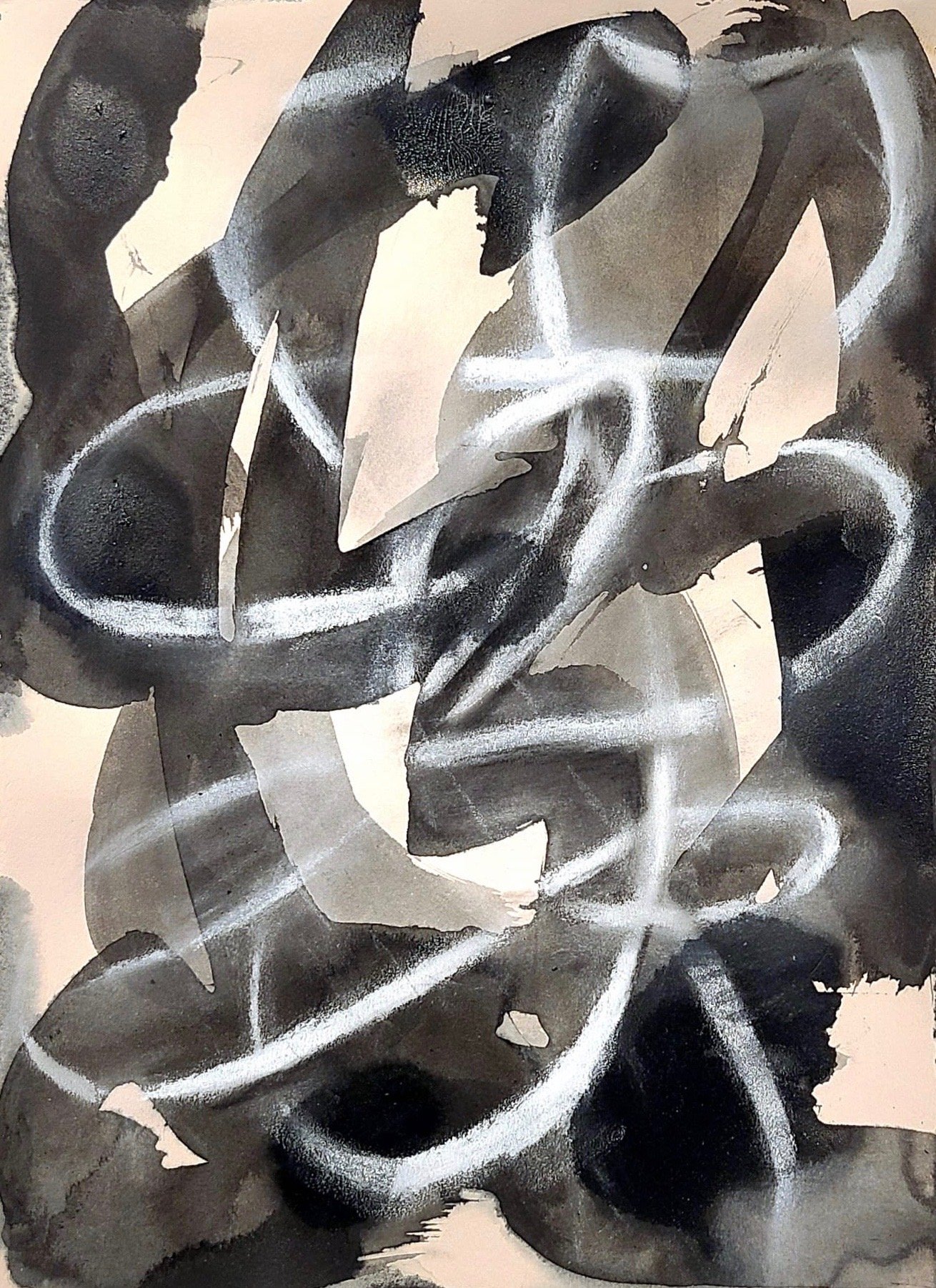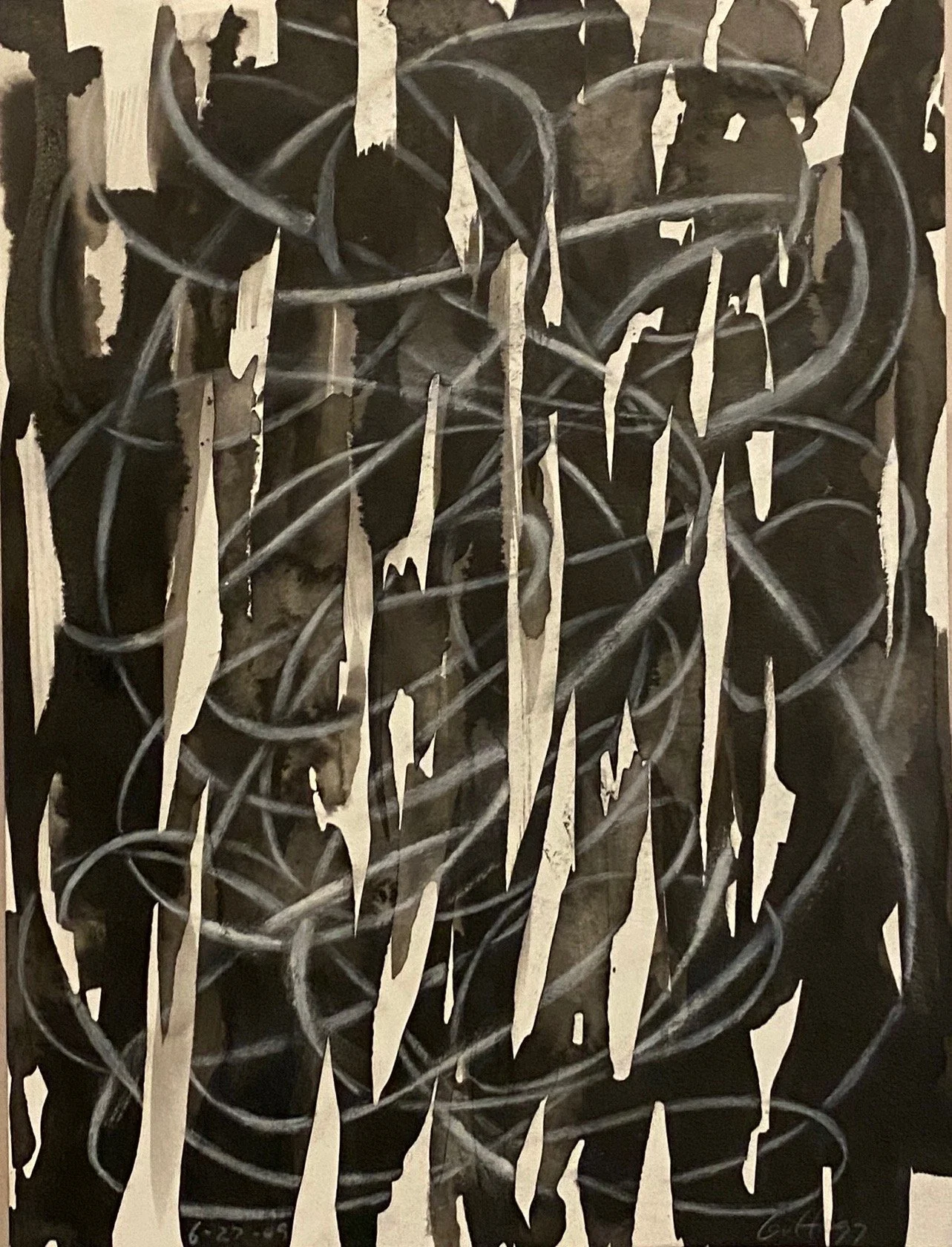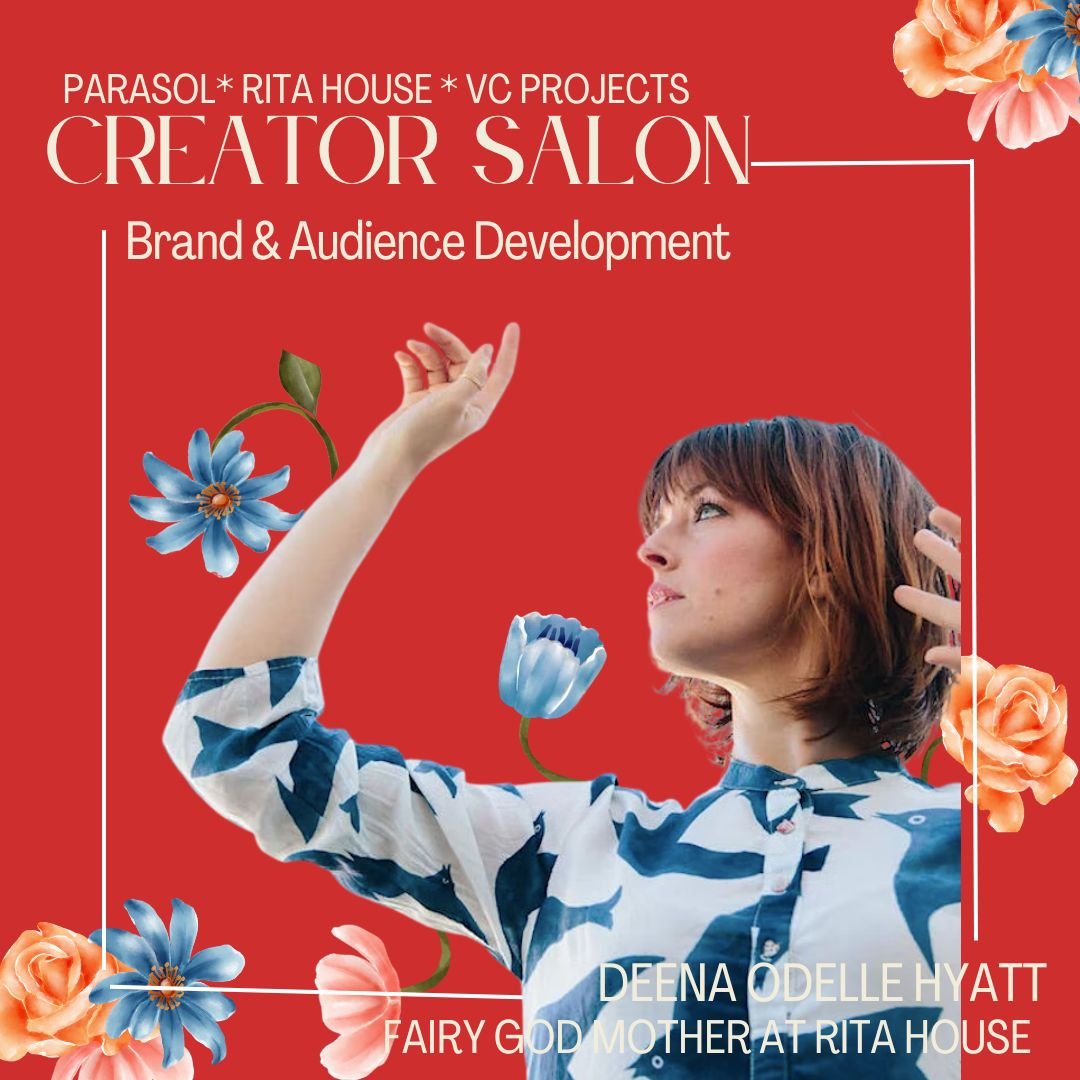TUESDAY, MARCH 28TH - CLOSING AND CURATORIAL TALK WITH ARTISTS
Xingu 2023
SHANE GUFFOGG: XINGU exhibition at Rita House from March 2 - 28th, 2023
Gallery hours: Tuesdays 3-7 pm and Wednesdays 2-5 pm or by appointment
Contact: hello@ritahouse.com
CLOSING Curatorial Talk, Tuesday, March 28th, 7 - 8 pm
with Shane Guffogg and Anthony Cardella
“THE LIFE OF THE ARTIST AND THE CREATIVE PROCESS”
An ongoing dialogue between curator and artists where they share thoughts and reflections exploring elements, influences, and rituals which segway into finding truth in daily art practice.
A note from the curator,
Shane returned from Venice, Vienna, and Budapest last night in preparation for his upcoming exhibition. Tony will perform just two compositions. One at the beginning and one at the end. Tony and Shane plus myself are super psyched about Tuesday!
I hope you will join us for this informal talk between Shane and Tony, where they share their thoughts and reflections exploring elements, influences, and rituals which segway into finding truth in daily art practice.
Regardless of your medium, this will be a fascinating discussion about staying true to your aesthetic. Shane always speaks eloquently about his artistic process and inquiry. Tony will equally share why he might select a piece and how he drives his emotions into the music—moderated by myself, and free to attend.
Last Spring, I interviewed Tony, “A Talk about Creativity” on VC Projects Podcast “Conversations About Art”, we learned about Tony’s early beginnings, what age his first concert was and what keeps him invested today while living in Los Angeles, where there are so many influences. However, it was the topic of creativity that mostly dominated this conversation. How does Tony bring creativity into his daily practice as a pianist? I was curious to hear about his thoughts regarding interpretation. And what about innovation as an entertainer/performer? Tony’s answers are especially interesting and important to contemplate in today’s world. I look forward to Tony being a part of our conversation with Shane Guffogg, where we unearth what it means to be an artist in the 21st century.
Shane and I, have published four conversations on “The Life of the Artist and the Creative Process, peering not only into Shane's studio practice but also my referencing historical and philosophical texts. For example, we have discussed excerpts from Hegel's "Phenomenology of Spirit" (1807), contemplating appearance and the super-sensible world when one loses their self to the senses. Interestingly, Hegel's book was written as a guide to define awareness as it pertains to truth and is one of the most famous philosophical texts discussing the history of consciousness.
Another reference we have touched on is the first letter in Rilke's book, "Letter to a Young Poet," which consists of ten letters Rilke exchanges with a young poet from 1903 - to 1908. These letters were based on writing advice, but the great writer shares his thoughts about living. The first letter is particularly insightful, as Rilke encourages the 19-year-old military cadet to connect with his inner soul to determine if he has the substance to find his truth as a poet. In addition to written conversations, I have published Soundcloud recordings of Shane explaining T.S. Eliot's "Four Quartets" and its influence on his work. Through this audio platform, Shane intimately shares what prompted him to create "At the Still Point of the Turning World," describing the great poet's influences on Shane's work. Just in this series alone, Shane has created over 80 paintings from 2009 - to the present.
Regarding spirituality, I have candidly asked Shane questions on this taboo subject not often discussed within the realm of arts. We have also discussed thoughts on transcendence, and relativity, something I felt a need to discuss when referencing the 2015 painting titled "What if Everything That was is, And Everything That is Never Was."
One thing is sure, during our ongoing conversations, Shane truthfully answers my questions surrounding the purpose of creativity and the arts as he shares his thoughts, introspectively measuring his experiences. I think Shane and I have published over 15 episodes of his work and his personal investigations via my podcast “Conversations About Art.”There is much to explore regarding the artist's life and the creative process. It just doesn’t end, from one artist to the next -- each story is uniquely rich that connects all of history. What is so often overlooked is sharing the journey, grounding each other, and forming a community. It’s easy to forget that quite often, each artist’s practice is pursued in isolation.
Thank you to Rita House and Parasol for giving us the space and friendship to share our stories.
Victoria Chapman
El NIDO by VC Projects
Anthony Cardella is a dynamic and compelling, active performer who has performed in esteemed concert halls across the United States and Europe and has won regional and national performance competitions in the United States.
Shane Guffogg working on “Evolution of a Mortal Soul - Amor Fati.”
THE PREVIOUS EVENT AT RITA HOUSE, MARCH 2, 2023 at 6:30 pm
PARASOL * RITA HOUSE * VC PROJECTS
Thursday, March 2, 2023, at 7 pm doors open at 6:30 pm
This event is located at RITA HOUSE, 5971 W. 3rd Street, Los Angeles, 90036
The Creator Salon is a monthly series developed to create a supportive space to fuel personal, professional, and collective growth while sparking new ideas and connections.
For the March Salon, we will explore the topic of building authentic brands and growing and creating a genuine connection with your audience.
This will be an evening of creative community building paired with an immersive art and music experience. Our panel speakers include Azy Saii (Universal Music, Amazon Studios) and Alan Sartriana (Anthemic Agency, Flood Mag) and an art experience and performance by Anthony Cardella in collaboration with artist Shane Guffogg.
ARTIST & PIANIST COLLABORATION
SHANE GUFFOGG: XINGU
Large to medium-scale works on paper and found art installation
Curated by Victoria Chapman of El NIDO by VC Projects
Music performance within the exhibition space by Anthony Cardella
Anthony Cardella, pianist
Anthony Cardella is a dynamic and compelling, active performer who has performed in esteemed concert halls across the United States and Europe and has won regional and national performance competitions in the United States. A Wisconsin native, Anthony moved to Los Angeles three years ago after completing his undergraduate studies at the Lawrence Conservatory of Music and has been performing, teaching, and collaborating in the Los Angeles area while pursuing further studies at the Thornton School of Music.
Anthony is an award-winning performer praised for his virtuosity, exceptionally delicate touch, and colorful playing that connects with his audiences emotionally. Anthony is known for assembling programs that showcase the full extent of his technical abilities and vulnerability at the piano in tandem while actively seeking out music written by living composers to program and showcase in addition to standard Classical repertoire.
Shane Guffogg, visual artist
Shane Guffogg was born in Los Angeles, California, and raised on an exotic bird farm in the San Joaquin Valley. His interest in painting began while a teenager when he traveled to Europe and the former Soviet Union and was exposed to the Masters. He received his B.F.A. from Cal Arts, and during his studies, he interned in New York City. Guffogg works in oil on canvas, paper, watercolor, gouache, pastel, and traditional etchings on zinc plates. Guffogg's language of light and color in the oil paintings manifested into glass, with the shapes originating from the negative spaces within his paintings, creating a visual duality of male and female, organic and architectural forms.
Shane Guffogg is an American artist who looks at past and present civilizations through the lens of humanity and views time as a thread that connects all people. His work is a visual language informed by the spiritualism of abstraction and the realism of the old masters. These two ideas are usually seen as separate but Guffogg fuses them seamlessly into works that transcend and become testaments to thoughts that inform us who we are in the 21st century. His artwork consists of oil paintings, mixed-media works on paper, pastels, and Murano glass sculptures.
Guffogg’s artwork can be found in numerous private and public collections and museums in Europe and the USA. Some notably the Los Angeles County Museum of Art, Hammer Museum, Los Angeles, Nasher Museum of Art at Duke University, New York, Fundación/Colección Jumex, Mexico City, The Imperial Museum of Fine Arts, St. Petersburg, Russia, The Gallery at the Museum Center, Baku, Azerbaijan, St. Patrick’s Cathedral, New York, Van Pelt-Dietrich Library, University of Pennsylvania, Frederick R. Wiseman Art Foundation, Los Angeles.
INTRODUCTION
SHANE GUFFOGG: XINGU
Shane Guffogg, Xingu 2, 2023
Sumi and India ink, with soft pastel on handmade French Lanaquarelle paper 51 x 79 inches
In 2023, Shane Guffogg returns to the Xingu series, consisting of medium to large-scale works on paper. The artist began this project in 2009. They began on the studio floor using a bottle of Sumi ink and a roll of Strathmore paper. "I like to think of invisible threads around us that connects everything, almost like a spider's web. If you touch one part of the web, the spider knows because it is connected. It is easy to forget or lose the idea of being inner connected due to all the white noise, which social media has amplified to a deafening level!"
The birth of Xingu came about during the same weekend the artist started his famous Still Point series. In his own words Guffogg describes the still points as "repetition of a line that circles in, on itself, over and over, until deep layers are formed, hovering in the finite space between chaos and order." With the Xingu series, the opposite approach was taken. “The paper was laid flat on my studio floor, and with quick, gestural brush strokes, the random application of ink was applied, leaving some areas of the paper clear, as if there was a tear in the black ink that allows us to see through to the white paper, making the paper both a subject and object. Once dry, I would pin the paper to the wall and draw lines in and around the black with a piece of white chalk. As the white chalk crossed over the empty areas, what was sitting on the surface of the paper disappeared into the white. These works are about the duality of all things, just like chaos and order, but from a different approach. The title, Xingu, is the name of an area where small rivers and streams come together to form the Amazon River. I think of the place, that moment, where the rivers merge, a moment of two becoming one, chaos and order, space and time."
Shane Guffogg is a California-based, international artist who has had a successful domestic and international career with solo exhibitions in USA and Western and Eastern Europe and the Middle East. Guffogg continually stays on cue to observe the world around him, never falling for trends but simply staying on his chosen course. He looks out onto the world that struggles with climate change, war, politics, identity, and the fragility of human existence. His observations are sincere, sharing the visual expression of the basic human and emotional survival needs, regardless of race, culture, language, or religion. His mission has always been to create a visual language that is comprehensible to all collectives and communities of the world. Often, he asks, "What do our thoughts look like before words are attached?" Partially, his creative language has long been inspired by the spirituality of abstraction. He looks deeply into the lens of humanity, and what we think, and the experiences that are felt and held close to heart.
Victoria Chapman, VC Projects, January 12, 2023, Los Angeles
PIANIST ANTHONY CARDELLA PERFORMS WITHIN THE XINGU INSTALLATION SPACE AND FEATURES AN EXPRESSIVE MUSIC PROGRAM FEATURING WORKS BY JANACEK, RAVEL, AND SCRIABIN
MUSIC PERFORMANCE
PROGRAM
Leos Janacek: In The Mists
I.Andante
II.Molto Adagio
Maurice Ravel: Miroirs
I.(Sad Birds)
Maurice Ravel: Gaspard de la Nuit
I.Le Gibet (The Gallows)
Alexander Scriabin: Piano Sonata No. 2 in G-Sharp Minor (Sonata-Fantasy)
I.Andante
II.Presto
MUSIC NOTES
Leos Janacek: In The Mists
I.Andante
II.Molto Adagio
Born in Moravia, a historical region in the east of the Czech Republic, Leos Janacek (1854-1928) was a talented pianist and composer, renowned for having a light touch at the keyboard. In the Mists, a four movement piano cycle, was composed by Janacek in 1912 during a troubling period in his life. Janacek had not yet reached great success professionally at the time, with his operas still being rejected by the Prague Opera House, and felt himself to be trapped in a disappointing career and an equally unhappy marriage following the death of his daughter, Olga, who died of Typhoid Fever. Janacek set out to compose In the Mists during this period, the last substantial piano work of his output, and ended up creating a work showcasing profound intimacy and emotional depth which sits right between the aesthetics of Eastern and Western Europe at the time.
Full of melancholy, In the Mists is a remembrance - a reflection on memories including the emotional journey through nostalgia, sparking both joy and pain. Sounds reminiscent of fiddles and hammered dulcimers from the Moravian folk music tradition are present, combined with small melodic fragments from folk traditions that are repeated and transformed in various, emotional ways. Janacek's harmonies here are informed by an Impressionist tradition, but channeled through his emotions and Moravian background to create a new, misty, harmonic landscape. Through these ambivalent tonalities, endless transformations of short melodic ideas, many changes of meter, and a rhapsodic-improvisational style, the music invites a different kind of listening which leads the listener through an emotional journey of remembrance.
Maurice Ravel: Miroirs
I.(Sad Birds)
Maurice Ravel (1875-1937), one of the most notable French composers of the Impressionist Era, composed a suite of pieces from 1904-1905 titled Miroirs. The set of five pieces was composed to describe members of Ravel’s band of friends who referred to themselves as Les Apaches, or “hooligans,” a popular term for describing Parisian street criminals at the time. Each piece is meant to be a mirror of a certain member of this group of musicians, writers, and artists. Oiseaux Tristes from this set was dedicated to the pianist and group member, Ricardo Viñes, who was the pianist which debuted the entire set. The other members who received dedications were Léon-Paul Farque (poet), Paul Sordes (painter), Michel D. Calvocoressi (music critic), and Maurice Delage (composer).
Like Janacek’s In the Mists, Ravel composed this set of pieces after a troubling series of professional failures. Ravel was expelled from the Paris Conservatory in 1895 because of his unusual ideas, as well as being “teachable only on his terms.” He was readmitted in 1897, and subsequently expelled again in 1900 for failing to win any prizes for his writing. This period included four failed attempts at winning the Prix de Rome competition, as well as a general lack of acceptance by the musical establishment in Paris due to Ravel’s progressive musical and political outlook. At this point, Ravel left Paris at the behest of his friend, Alfred Edwards, and sailed around Holland for some time, likely finding inspiration which may be seen in the third movement of Miroirs - A Boat on the Ocean. Following this trip, Ravel returned to Paris and Les Apaches was formed. In a span of three years Ravel wrote some of the most monumental piano repertoire including Miroirs (and Gaspard de La Nuit) which remains as some of the most pictorially vivid – and technically challenging – writing in the piano repertoire to this day.
Ravel described the title of the set, Miroirs, as follows:
The title Miroirs (Reflections), five piano pieces composed in 1905, has authorized my critics to consider this collection as being among those works that belong to the Impressionist movement. I do not contradict this at all, if one understands the term by analogy. A rather fleeting analogy, at that, since Impressionism does not seem to have any precise meaning outside the domain of painting. In any case, the word ‘Mirror’ should not lead one to assume that I want to affirm a subjectivist theory of art. A sentence by Shakespeare helped me to formulate a completely opposite position: ‘the eye sees not itself / but by reflection, by some other things’ (Julius Caesar, act I, Scene 2).
Ravel intended these mirrors to be a personal but objective painting of the images - a pictorial description rather than a subjective expression of feeling. With this in mind, Ravel described Oiseaux tristes as “birds lost in the torpor of a very dark forest during the hottest hours of summer.” As the piece opens we hear one solitary bird, singing alone, but soon joined by others. Fauré describes the texture as follows: “Fundamentally Ravel set store by the player bringing out two levels: the birdcalls with their rapid arabesques on a higher, slightly strident level and the suffocating, somber atmosphere of the forest on a lower level which is rather heavy and veiled in pedal without much movement.”
Maurice Ravel: Gaspard de la Nuit
I.Le Gibet (The Gallows)
Gaspard de la Nuit is a suite of three piano pieces composed by Ravel in 1908. Each piece is based on a poem from the collection Gaspard de la Nuit by Aloysius Bertrand. The work was premiered in Paris in 1909, again by pianist and fellow Les Apaches member, Ricardo Viñes.
Aloysius Bertrand attributes the origins of these poems to a mysterious, old man whom he met in a park in Dijon. The old man describes his journey through life in search of art and the meaning of art. After this, he gives Bertrand the book of poems saying that he is leaving to write his will and that he would return the following day to retrieve the book once Bertrand has read the poems. Bertrand returns the next day, but the old man does not. Upon asking about the old man, Bertrand is told that he is probably in Hell, or off on his travels as he is, afterall, the devil. Bertrand then remarks: “May he roast there! I shall publish his book!”
Le Gibet
Que vois-je remuer autour de ce Gibet?
– Faust.
What do I see stirring around that gibbet?
– Faust.
Ah! ce que j'entends, serait-ce la bise nocturne qui glapit, ou le pendu qui pousse un soupir sur la fourche patibulaire?
Ah! that which I hear, was it the north wind that screeches in the night, or the hanged one who utters a sigh on the forked gallows?
Serait-ce quelque grillon qui chante tapi dans la mousse et le lierre stérile dont par pitié se chausse le bois?
Was it some cricket who sings lurking in the moss and the sterile ivy, which out of pity covers the floor of the forest?
Serait-ce quelque mouche en chasse sonnant du cor autour de ces oreilles sourdes à la fanfare des hallali?
Was it some fly in chase sounding the horn around those ears deaf to the fanfare of the halloos?
Serait-ce quelque escarbot qui cueille en son vol inégal un cheveu sanglant à son crâne chauve?
Was it some scarab beetle who gathers in his uneven flight a bloody hair from his bald skull?
Ou bien serait-ce quelque araignée qui brode une demi-aune de mousseline pour cravate à ce col étranglé?
Or then, was it some spider who embroiders a half-measure of muslin for a tie on this strangled neck?
C'est la cloche qui tinte aux murs d'une ville sous l'horizon, et la carcasse d'un pendu que rougit le soleil couchant.
It is the bell that tolls from the walls of a city, under the horizon, and the corpse of the hanged one that is reddened by the setting sun.
Ravel wrote, "My ambition is to say with notes what a poet expresses with words." Listen for the complicated depths of mood conjured in this piece where the score requires three staves to notate the isolated terraces of sound that the pianist must sustain. Hear the sounds of the distant bell tolling ceaselessly throughout, the reddening sunset glow, the ghastly corpse swaying. Ravel portrays the scene with a chilling simplicity and the entire focus of the piece is the creation of this eerie atmosphere, sustained by a B-flat ostinato that sounds throughout the entire piece. On first sight of the score, the music looks fairly straightforward (especially compared to the outer movements), but its difficulty lies in independence of the hands and controlling discrete dynamic gradations of pp and ppp. Vlado Perlemuter (a student of Ravel) remarks that this is one of his favorite pieces by Ravel, but that it is also one of the most complicated pieces to play because the pianist must not be afraid of making it sound monotonous and must have complete control over the keyboard to produce all of these independent sonorities with only two hands.
Alexander Scriabin: Piano Sonata No. 2 in G-Sharp Minor (Sonata-Fantasy)
I.Andante
II.Presto
Alexander Scriabin (1871-1915) was a Russian pianist and composer, and is often considered the main Russian Symbolist composer. Scriabin studied at the Moscow Conservatory at the same time as Rachmaninoff, and even graduated in the same year. With this in mind, Scriabin’s writing in his early years is very romantic and somewhat impressionistic, with such a strong influence from Chopin that he was referred to as “Russia’s Chopin.” Scriabin graduated in 1892 but did not complete his composition degree because of his musical differences with his teacher, Anton Arensky, and his unwillingness to compose pieces in forms that did not interest him. Scriabin also injured his hand during his studies at the Moscow Conservatory while playing intense works by Liszt and Balakirev. His doctor said he would never recover, and Scribain then wrote his first published piano sonata as a “cry against God, against fate,” which became his first large-scale masterpiece. Following this painful period, Scriabin began writing his second piano sonata in 1892 after a trip to the Baltic Coast where he had his first unforgettable encounter with the sea. In a letter, Scriabin wrote:
“Everything glowed with magnificent majesty on the horizon. First a clear purple, then it turned rose-colored, and finally silvery flecks stained the surface of the sea…. The green of the sea blended with the blue reflection of the sky. There was such a play of colors and shades as I've never seen. It was a picture, a triumph of colors, a festival of truth.”
It took Scriabin another five years, and several more oceanside trips, before finally completing the sonata in 1897. It was titled “Sonata-Fantaisie,” and Scriabin provided his own description of the two-movement work:
“…the first movement represents the quiet of a southern night on the seashore; the development is the dark agitations of the deep, deep sea. The E-major middle section shows caressing moonlight coming after the first darkness of the night. The second movement, Presto, represents the vast expanse of ocean stormily agitated.”
At this point, Scriabin was still writing in a very romantic style, with subtle indications of the experimental directions which lay ahead for the composer. Scriabin later abandoned the traditional use of tonality and developed a much more dissonant musical language that transcended the use of tonality but was not atonal, in his eyes. He designed this musical language around a combination of his Synesthesia (a perceptual phenomenon in which stimulation of one sensory or cognitive pathway leads to involuntary experiences in a second sensory or cognitive pathway - in Scriabin’s case, an association between color and sound) and his beliefs in theosophy. In the color scheme Scriabin would devise later in his life, the key of E Major (the relative major to the key of this sonata, G-Sharp Minor) is a light cool blue.
ARTWORK
SHANE GUFFOGG: XINGU series
Shane Guffogg, Xingu 1, 2023
Sumi and India ink, with soft pastel on handmade French Lanaquarelle paper 62 x 51 inches
Shane Guffogg, Xingu 2, 2023
Sumi and India ink, with soft pastel on handmade French Lanaquarelle paper 51 x 79 inches
Xingu 3, 2023
Sumi and India ink, with soft pastel Handmade French Lanaquarelle paper 30 x 22 inches
Xingu 4, 2023
Sumi and India ink, with soft pastel Handmade French Lanaquarelle paper 30 x 22 inches
Xingu 5, 2023
Sumi and India ink, with soft pastel Handmade French Lanaquarelle paper 30 x 22 inches
Xingu 6, 2023
Sumi and India ink, with soft pastel Handmade French Lanaquarelle paper 30 x 22 inches
Xingu 7, 2023
Sumi and India ink, with soft pastel Handmade French Lanaquarelle paper 15 x 11 inches
Xingu 8, 2023
Sumi and India ink, with soft pastel Handmade French Lanaquarelle paper 15 x 11 inches
Xingu 9, 2023
Sumi and India ink, with soft pastel Handmade French Lanaquarelle paper 15 x 11 inches
Xingu 10, 2023
Sumi and India ink, with soft pastel Handmade French Lanaquarelle paper 15 x 11 inches
Xingu, 2020-1 Sumi ink, with soft pastel, Handmade cold-press paper 30 x 22 inches
Xingu, 2020-2 Sumi ink, with soft pastel Handmade paper, 12 x 9 inches
ART CURATOR
VC PROJECTS
Victoria Chapman, curator
VC Projects was founded in 2014 by British-born Victoria Chapman, a Los Angeles-based curator and The School of the Museum of Fine Arts Boston graduate at Tufts University. VC Projects was created to assist artists with their studio and exhibition development and representation at art fairs.
Chapman has spent over twenty-five years working domestically and internationally in a variety of means with art directors, curators, art consultants, artists, galleries, museums, and art institutions, assisting with administrative, curatorial, and exhibition planning. Chapman’s work experience has taken her to museums such as The Isabella Gardener Museum, The Victoria and Albert Museum, Orange County Museum of Art, and the Laguna Art Museum. She also worked as an Art Director for Daniel Fine Art Services for over sixteen years, working alongside senior curators to create art collections for boutique hotels.
For the past seven years and as of present, Chapman has been the Studio Director for Shane Guffogg, a Los Angeles-based international artist with a long and honorable career in visual arts, augmented reality, and sound experiments. Chapman is also a published writer, speaker, and mentor regarding art history and the creative process. In 2022, she was selected as Featured Curator for “Small Talks” (England). Previously, she was featured on Calls with CURA, The Garden HIERONYVISION arts community, Art Confidential Magazine, and LACP’s Conversations with a Curator (Los Angeles). Another aspect of her curatorial program is VC Projects Podcast: Conversations About Art featured on Spotify, where she has produced over 24 episodes, and El Nido’s Sound Cloud, where she captures 5 to 10 min sound bites on the creative process by selecting artists. In addition to producing art programs, Chapman has been a selected Portfolio Reviewer for the Los Angeles Center of Photography from 2020 to forth-coming 2023. Lastly, Chapman is a Contributing Curator and Liaison to Casa Regis: Center for Culture and Contemporary Art, Italy, and a club member of Cromwell Place, an art exhibitions space, in London, England.
ABOUT THE PANELISTS
Alan Sartirana
CEO & Founder, Anthemic Agency, Flood Magazine and Flood FM, President & Co-Founder, Louder than Bombs Productions
As CEO and Founder of the award-winning ANTHEMIC Agency and Publisher and Founder of FLOOD Magazine, Alan Sartirana is an industry stalwart who is regarded as one of the leading voices in culture, music, lifestyle, and branding. ANTHEMIC is a collective of creative and engaged industry leaders who cultivate extraordinary experiences that inspire and influence culture. Sartirana leads the full-service brand and culture agency in its unique approach to experiential marketing, brand partnerships, media campaigns, public relations, and content strategy, with clients and projects that include Toyota, Bowers & Wilkins, Saatchi & Saatchi, Guitar Center, Burton, the John Lennon Educational Tour Bus, and more. Sartirana is also the founder of FLOOD, an online and print media publisher spanning the landscape of film, music, art, travel, and everything in between, featuring everyone from Run the Jewels, Neil Young, Big Grams, and Iggy Pop to fashion spreads featuring John C. Reilly’s Dr. Steve Brule and the cast of HBO’s Veep.
Azy Saii
Growth & Marketing Leader | Deep CX, E-Commerce, Performance Marketing, Data & Tech Expertise | Accelerated Growth For Industry Leaders: Universal Music Group, FOX, Experian & NewsCorp
Azy Saii is a global marketing leader with a history of achievement unlocking growth for Fortune 500 brands and start-ups in the media, entertainment and consumer tech space. She is currently an independent advisor mainly helping media and entertainment brands of all sizes optimize their marketing, operations and infrastructure to scale performance. This includes her recent role as the marketing integration lead for Amazon Studios, following their $8.5B acquisition of MGM, where she helped develop a future-state vision across the two studios. Prior to consulting, Azy held several marketing executive posts where she spearheaded performance turnarounds and digital transformation.
As the senior vice president of global audience development at Universal Music Group (UMG) she steered a data-powered growth strategy, creating a competitive advantage for the label in its ability to support artist’s accelerate their commercial success. She led the marketing technology and data vision, as well as created a performance marketing center-of -excellence to support the label businesses in acquiring new fans, creating engaged digital experiences and driving targets campaigns to yield an average of 10M incremental fans and 130% increase in response rates per artist campaign. Some of the most successful album release campaigns she contributed to were Taylor Swift’s Red (Taylor’s Version), Lorde’s Solar Power, Stromae’s Multitude launch in North America and The Weeknd’s release of After Hours.
Prior to UMG, Azy served as the head of marketing for Fox’s direct-to-consumer business unit, which launched their first digital product across a portfolio of four networks - FOX,FX, National Geographic and FOX Sports. Her launch of the digital-first business helped capture an incremental $71M in revenue and grow FOX’s owned consumer base from 0 to 10M within one year. She also managed two performance turnarounds for Experian, the world’s largest data company, in both UK and North America where she served as the marketing and customer experience leader on the executive leadership team of their consumer services business.
Her early career was built in the UK and Canada, during the onset and rise of digital consumption and commerce. In hands-on digital and performance marketing roles, she facilitated GTM success and led early innovation in digital marketing for brands like BSkyB, Vonage, Telus and AOL.
She’s recognized for her deep data and technology fluency and a passion for creating authentic connections between brands and fans that simultaneously translate into value exchange.
Raised in Canada, Azy graduated from the University of Victoria with a bachelor of commerce and major in international business. She now calls Los Angeles home, where she lives with her two boys and husband. She is currently completing a certificate in Blockchain Technologies: Business Innovation and Application at MIT.
ABOUT THE HOSTS
PARASOL
Founded by Grace Hong and Martin Wave
Parasol curates transformational events fostering human connection and bridging the business, creative, and mindfulness communities. At the organization's heart is a conscious community of artists, entrepreneurs, and next-level thinkers dedicated to supporting other creators and creating a positive future vision.
Grace has a multi-faceted career across the business, the arts, and the non-profit spheres. She is a Senior Advisor at the private equity firm TPG Global, an artist/music producer known as Nolo Grace, and serves on the Board of Directors of two non-profits (OpenSecrets and Save the Music). Martin is an award-winning, platinum-selling music producer, composer, and artist with an expansive career spanning pop, film, TV, gaming, and major placements with brands on commercial campaigns. His music has hundreds of millions of streams, including a global #1 selling album, and collaborations with artists like Steve Aoki, ALOK, NCT DREAM, Post Malone, Kasey Musgraves, Vince Staples, Masego, Bas, and more.
RITA HOUSE
Rita House is 9,000 square feet of vintage Hollywood charm. The space is used for co-working, events, dinner parties, writer's tables, conferences, and as a location for film and photography. Some of clients and collaborators have included: Netflix, United Nations Women, ESPN, Notion.io, Simon Sinek, SpaceX, Warner Brothers Music, The Jim Henson Company, BBC, VICE, MedMen, Disney+, Hypebeast, I Heart Radio and more.
Originally built in 1926 as a Prop Design Studio for film and television, this space also spent twenty years as a violin factory before Emmy Award Winning Costume Designer Rita Riggs purchased the building In 1967 and made it her studio where she worked closely with legends such as Alfred Hitchcock to Norman Lear. Rita predated the current interest in shared community office space by offering space for coworking and creative offices starting in the 70s. When Rita passed five years ago she passed the building onto Architects and Rita House Founding partners Scott Strumwasser and Tash Rahbar. They, along with Event & Community Director Deena Odelle Hyatt keep her creative spirit alive in this unique, multiuse space.
THE LONG ESSAY
SHANE GUFFOGG: XINGU
In 2023, Shane Guffogg returns to the Xingu series, consisting of medium to large-scale works on paper. The artist began this project in 2009. They began on the studio floor using a bottle of Sumi ink and a roll of Strathmore paper. Additional marks were added with soft white paste charcoal. This serie, then and now, is about the connection of everything. For the 2023 exhibition on Western Avenue, the series, Xingu, was created in his Central California studio, returning to the nature of all things in existence and expiration.
“I like to think of invisible threads around us, connecting everything, almost like a spider’s web. If you touch one part of the web, the spider knows because it is connected. It is easy to forget or lose the idea of being inner connected due to all the white noise, which social media has amplified to a deafening level!”
The birth of Xingu came about during the same weekend the artist started his famous Still Point series. In his own words Guffogg describes the still points as “repetition of a line that circles in, on itself, over and over, until deep layers are formed, hovering in the finite space between chaos and order.” With the Xingu series, the opposite approach was taken …
“The paper was laid flat on my studio floor, and with quick, gestural brush strokes, the random application of ink was applied, leaving some areas of the paper clear, as if there was a tear in the black ink that allows us to see through to the white paper, making the paper both a subject and object. Once dry, I would pin the paper to the wall and draw lines in and around the black with a piece of white chalk. As the white chalk crossed over the empty areas, what was sitting on the surface of the paper disappeared into the white. These works are about the duality of all things, just like chaos and order, but from a different approach. The title, Xingu, is the name of a river in Brazil that feeds into the Amazon river. I think of where the two rivers merge, a moment of two becoming one, chaos and order, space and time.”
But that’s not all the exhibition brings about; it also shares aspects of the artist’s studio in Central California. The 2023 Xingu series was created amongst an abundance of nature, sprawling landscapes filled with farmland, trees, and mountains. This factor is key in acknowledgment and respect to the observation of growth and decay. Spinoza, the 17th-century Dutch philosopher, believed in the inherent nature of all things and that there is an interwoven connection that flows between all beings and all existence — there is no dead end. “In nature, there is nothing contingent; all things have been caused by the necessity of the divine nature to exist and produce an effect in a certain way.”
For this art installation, Guffogg has brought a branch from the top of a Eucalyptus tree that was struck by lighting and snapped off in the latest California storm. This object represents Guffogg’s ongoing observations of the landscape around him, consisting of sprawling farmland. The area produces the majority of the country’s food source due to the risch soil, as the land was once a lake bed used by earlier settlers. What the artist observes during the day and night is growth and decay within the order of what is inherent and majestic. These daily observations, which come and go with the seasons (which range from the high of 30 degrees in winter to 110 degrees in summer), have their share of destruction and renewal.
When I asked Guffogg about the title, he said, “The first time I used the word Xingu was for a 7 x 7 foot painting I made in Los Angeles. The works on paper were started at my ranch studio in 2009. I think being more in nature or around orchards of trees affects me because when I see a tree,I also see the sky behind it through the branches, similar to looking beyond the black surface into the white void of the paper.
Within my ongoing dialogue with the artist about his creative process, he has always explained to me, “It’s about asking the right questions.” By asking questions, your findings will reveal themselves. I think yearning and curiosity go hand in hand, and inquiry leads to thoughts that become ideas. This all might be unconscious, and the visuals may come in dreams or moments of realization. Over time, after nurturing these ideas, some of these concepts reveal themselves as discoveries, which come forth through making art. These magical moments of creativity are recorded in various mediums, which can be shared, and the observer receives a certain gift. That’s when I am transfixed, lost in time and space within the lines of Xingu, experiencing being in the moment. This is what drives me back to your studio to see your art and continue these conversations. My question to you is, what does this mean to you as the maker?
“I am both the creator and observer, so what you are saying and how you are describing your experience is very similar to what happens to me. As the observer, I am witnessing myself as the maker, which is a way to explain the subconscious and conscious mind, and the art is the bridge that connects both.”
But how did Guffogg come across the word Xingu? As much as the exhibition is about time and space, I believe the works and the tree branch give the viewer a sense of nature’s cycle of life and death; where does the title come from? And is the artist a source of time and space? How does the artist become the observer who is observed? I ask Guffogg if he is time and space. Guffogg kindly responds with:
“Ah, now we have come full circle where the beginning is the end, and the end is? The ideas or images of future paintings come to me in dreams or just walking, especially in nature. But they don’t come as a complete picture. They are more sensorial. This morning, I was walking along a field of corn, and the morning sun was shining through the leaves of a lone stalk of corn, changing the dark green to yellow-green. That made me think about light in general and how it can pass through some things, changing their colors. Then I think about my work and how I capture this moment in paint. By the time I am back in my studio, that moment is now a memory, but I can sensorial relive it, which sets up the moment to begin painting.”
Guffogg goes on to re-tell how the name came about. In the early 90s, he was getting some slack from Paul Ruscha about titling his work “Untitled and assigning them numbers.” One day while having lunch with Paul and Pat Poncy, who worked for Ed Ruscha, the subject was broached again. Pat was reading a book of short stories by Edith Wharton, and the name Xingu was the title of one of the stories. Pat wrote down a list of words from the Wharton book, which they then discussed and began to connect titles to paintings. Guffogg later researched the word and found it to be small rivers that meet to create the Amazon, and it was the perfect title for the large 7 x 7-foot painting he created. A radar screen initially inspired the patterns of the painting he found in a magazine. As with most of the artist’s work, the duality of chance and order plays a key role, which he feels is an endless opportunity to observe and explore in multiple creative aspects.
Xingu the exhibition is a refreshing look at Guffogg’s work in 2023, a California-based, international artist who has had a successful domestic and international career with solo exhibitions in USA and Europe. Guffogg continually stays on cue to observe the world around him, never falling for trends but simply staying on his chosen course. He looks out onto the world that struggles with climate change, war, politics, identity, and the fragility of human existence. His observations are sincere, sharing the visual expression of the basic human and emotional survival needs, regardless of race, culture, language, or religion. His mission has always been to create a visual language that is comprehensible to all collectives and communities of the world. Often he asks, “What do our thoughts look like before words are attached?” Partially, his creative language has long been inspired by the spirituality of abstraction. He looks deeply into the lens of humanity, and what we think, and the experiences that are felt and held close to heart.
Victoria Chapman, Curator
January 12, 2023, Los Angeles
REFLECTIONS ON ART AND MUSIC
VC (Victoria Chapman) proposes some questions to Shane Guffogg
I haven't understood a bar of music in my life, but I have felt it.”
― Igor Stravinsky
VC: When Shane and I decided to curate an exhibition of the Xingu series, I did not foresee a musical score to follow; the natural rhythms were already in the artwork. The splashes of black ink had a percussive element in contrast to white spaces, which for me, represented space and even silence. Then there is the charcoal running in and out. What did this all mean? Over tea one night, I shared the series with Tony; within seconds, due to his extensive knowledge of art and music, he began to have me listen to compositions from his cellphone that expressed the internal landscape he felt based on what he saw in the artwork. It was a beautiful transformation that words could never relay. Tony’s connection to the visual language was immediate; he felt Shane’s transcription from the heart – to the body to paper.
Tony shared some music notes that I studied; I was surprised to read Czech composer Leos Janacek: (1854-1928) work, In the Mists (1912), was partly inspired by folk music; the piece has a great deal of variation like Xingu series, there is light and dark tones, and a layer of soft white charcoal that flows in between the two bodies that could be interpreted as rivers. The open white spaces contrast harmoniously with the heavy black strokes, inducing an emotional encounter. I believe there are moments of detachment too.
I also learned Janacek’s composition is considered a work of impressionism. Tony begins the music program with this composition, it sets the listener up for their own narrative, weaving in and out of Shane’s Xingu and reflect on the emotional passages of Janacek’s “In the Mist.”
I was curious to ask Shane if he saw Xingu as impressionism.
Shane: I am not sure Impressionism is the right word. The French Impressionists were capturing a moment or an impression of a moment. I think the same is true with Impressionism and how it relates to music. For me, the Xingu series is about a sensorial impression that summons memories of moments. Not actual memories of a specific time or place but a sensorial memory, a feeling that is within and cannot really be explained. The black ink gives way to the paper causing what almost looks like a tear or an area that has withered away and exposes what is underneath. The white soft pastel lines have a presence against the black but then vanish against the white of the paper. It causes the surface to fluctuate between an illusion and reality. Life can be like that – our thoughts about a moment are not always the same as the reality of the moment.
VC: Tony will be performing Oiseaux Tristes (Sad Birds) by Ravel, who was regarded as a leading composer of the Impressionist period. When asked about the meaning of this composition, Ravel gave hint that the five compositions were written to describe his band members and friends, but not only that, failures in life.
“In any case, the word ‘Mirror’ should not lead one to assume that I want to affirm a subjectivist theory of art. A sentence by Shakespeare helped me to formulate a completely opposite position: ‘the eye sees not itself / but by reflection, by some other things’ (Julius Caesar, act I, Scene 2).
Ravel intended these mirrors to be a personal but objective painting of the images - a pictorial description rather than a subjective expression of feeling.
Shane, Do you think about mirrors in your work and how they may amplify an impression?
Shane: I think my works are all self-portraits in one form or another. The colors I choose to work with on any given day is a reflection of what I am feeling emotionally. The shapes I make is an extension of what I am thinking. So, I guess in one sense, they are mirrors, but not in the normal way we think of mirrors as reflecting back an image. I do think that somewhere between the viewer and the art, in that space, there is a suspended moment that allows the viewer to feel what was set in motion by the artist.
Le Gibet (The Gallows) by Ravel is an emotional composition, with segments of dark shadows countering a lingering call for light. There is a sense of mystery too. There is no doubt Prokofiev’s Toccata composition is incredibly complex. What I love about this work is the piano’s percussion aspect. The black and white in Xingu is a counter play.
What does this composition mean to you?
Shane: I have listened to this piece while painting and for me the rapid percussion-like play with the piano keys and the notes that flitter from major to minor and really aligning with the black and white, the opposites thrown together and forced to exist in a moment. There are also primitive but yet, deeply complex movements happening that are similar to the polarity of black and white. The white lines in my pieces bridge the two worlds as does the abstract melody of this piece.

